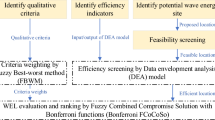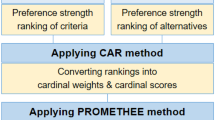Abstract
Chile’s 2050 energy policy ultimate goals are to produce a sustainable model of economic growth respectful of the environment where energy is produced efficiently and reliably. Renewable energy sources are considered the main drive for developing by 2050 at least 70% of the total energy in Chile. This study aims to provide a quantitative analysis for the selection of the most sustainable energy production methods using the compromise ranking method (VIKOR) that uses maximum group utility for the majority and a minimum of individual regret for the opponent. Since all evaluations are provided via intervals, the possible degree theory is used to compare them. Nine major criteria are critically used for this purpose and prioritized using analytical hierarchical process (AHP). Since Chile’s energy production matrix still relies heavily on fossil fuels with major concerns of GHG emissions, all major potential energy sources in Chile are considered including ocean energy in addition to nuclear energy. This study shows that biomasses are the best compromise solution and that traditional and modern nuclear energy plants score consistently better than solar power. Large hydro power plants rank very high but in light of the social opposition present in the country, they might not be easy to build as hoped. Ocean power is far superior to geothermal energy and comparable to wind power and for this reason it should be considered together with nuclear power for the future Chilean energy matrix.



Similar content being viewed by others
References
Jianping, L., Minrong, L., Jinnan, W., Jianjian, L., Hongwen, S., Maoxing, H.: Report on Global Environment Competitiveness of Chile, 2014, Current Chinese Economic Report Series. Springer, Berlin (2014)
Yoo, Seung-Hoon: Kwak, So-Yoon, Electricity consumption and economic growth in seven South American countries. Energy Policy 38(1), 181–188 (2010)
Gobierno de Chile, Ministerio de Energia, Proyectos en Construcción e Inversión en sector Energía a Enero (2017)
Ureta, Sebastian: A very public mess: problematizing the “participative turn” in energy policy in Chile. Energy Res. Soc. Sci. 29, 127–134 (2017)
Haas, J., et al.: Sunset or sunrise? Understanding the barriers and options for the massive deployment of solar technologies in Chile. Energy Policy 112, 399–414 (2018)
OECD (Organization for Economic Cooperation and Development): Environmental Performance Reviews: Chile 2016, OECD Publishing, Paris (2016)
Escobar, R.A., et al.: Estimating the potential for solar energy utilization in Chile by satellite-derived data and ground station measurements. Sol. Energy 121, 139–151 (2015)
Chu, S., Cui, Y., Liu, N.: The path towards sustainable energy. Nat. Mater. 16, 16–22 (2017)
Pohekar, S.D., Ramachandran, M.: Application of multi-criteria decision making to sustainable energy planning—a review. Renew. Sustain. Energy Rev. 8, 365–381 (2004)
Opricovic, S., Tzeng, G.-H.: Extended VIKOR method in comparison with outranking method. Eur. J. Oper. Res. 178(2), 514–529 (2007)
Deng, H., et al.: Inter-company comparison using TOPSIS with objective weights. Comput. Oper. Res. 27, 963–973 (2000)
Rao, R.V.: A decision making methodology for material selection using an improved compromised ranking method. Mater. Des. 29, 1949–1954 (2008)
Liou, J.J., et al.: A modified VIKOR multiple criteria-decision making method for improving domestic airlines service quality. J. Air Transp. Manag. 17, 57–61 (2011)
Jahan, A., Edwards, K.L.: VIKOR method for material selection problems with interval numbers and target-based criteria. Mater. Des. 47, 759–765 (2013)
Topcu, Y.I., Ulengin, F.: Energy for the future: an integrated decision aid for the case of Turkey. Energy 29, 137–154 (2004)
Kaya, T., Kahraman, C.: Multicriteria renewable energy planning using integrated fuzzy VIKOR & AHP methodology: the case of Istanbul. Energy 35, 2517–2527 (2014)
Kaya, T., Kaya, I.: Prioritization of renewable energy alternatives by using integrated fuzzy MCDM model: a real case application for Turkey. Renew. Sustain. Energy Rev. 80, 840–853 (2017)
Boran, F.E., Boran, K., Menlik, T.: The evaluation of renewable energy technologies for electricity generation in Turkey using intuitionistic fuzzy TOPSIS, 2012. Energy Sources Part B 7, 81–90 (2012)
Sharma, D., et al.: Selection of India’s energy resources: a fuzzy decision making approach. Energy Syst. 6, 439–453 (2015)
Nasirov, S., Agostini, C.A., Silva, C.: An assessment of the implementation of renewable energy sources in the light of the concerns over Chilean Policy objectives. Energy Sour. Part B: Econ. Plan. Pol. 12(8), 715–721 (2017)
San Cristobal, J.R.: Multi-criteria decision-making in the selection of a renewable energy project in Spain: the Vikor method. Renew. Energy 36, 498–502 (2011)
Wanga, B., et al.: A decision model for energy resource selection in China. Energy Policy 38, 7130–7141 (2010)
Markou, G., Genco, F.: Seismic assessment of small modular reactors: NuScale case study for 8.8 Mw Earthquake in Chile. Nuclear Eng. Des. 342, 176–204 (2019)
Soni, V., Singh, P., Banwet, K.D.: Precise decisions in Indian energy sector by imprecise evaluation. Int. J. Energy Sector Manag. 10(1), 118–142 (2016)
Oprinovic, Serafim: Tzeng, Gwo-Hshiung, Comparative Solution by MCDM methods: a comparative analysis of VIKOR and TOPSIS. Eur. J. Oper. Res. 156, 445–455 (2004)
Garcia-Cascales, M., Socorro, L., Teresa, M.: On rank reversal and TOPSIS method. Mathematicla Model 56, 123–132 (2012)
Bagla, V., Gupta, A., Mehr, A.: Improving consistency of Comparison matrices in analytical hierarchy process. Int. J. Curr. Eng. Technol. 3(2), 316–321 (2013)
Jarek, Slawomir: Removing inconsistency in pairwise comparison matrix in the AHP. Multiple Criteria Decision Making 11, 63–76 (2016)
Ilunga, M.: An Approach for achieving matrix consistency in AHP for an online module evaluation. In: Proceeding of the 11th international Multi-Conference on Society, Cybernetics and Informatics (IMSCI 2017) (2017)
Liu, Wanzhen: VIKOR Method for group decision making problems with ordinal interval numbers. Int. J. Hybrid Inf. Technol. 9, 67–74 (2016)
Ministerio de Energia, Comision Nacional de Energia (CNE), Anuario Estadistico de Energia, Chile (2017)
de Energia, Ministerio: Energy 2050, Chile’s Energy Policy. Santiago, Chile (2015)
Ministry of Energy, Chile: Agenda de Energía 2014–2018. Santiago, Chile (2014)
Varas, P., Tironi, M., Rudnick, H., Rodríguez, N.: The growing social challenges of hydroelectric development. IEEE Power & Energy Magazine (2013)
CIFES Report July. Centro Nacional para la Innovación y Fomento de las Energías Sustentables (2016)
Agostini, C.A., Nasirov, S., Silva, C.: Solar PV planning toward sustainable development in Chile: challenges and recommendations. J. Environ. Dev. 25(1), 25–46 (2016)
Mattar, Christian, Dager, B.: Offshore wind power simulation by using WRF in the central coast of Chile. Renew. Energy 94, 22–31 (2016)
Gobierno de Chile, Comision Nacional energia, Energia Abierta, Total Installed Capacity. http://energiaabierta.cl/visualizaciones/capacidad-instalada/
Sanchez-Alfaro, P., et al.: Geothermal barriers, policies and economics in Chile—lessons for the Andes. Renew. Sustain. Energy Rev. 51, 1390–1401 (2015)
Mo̸rk, G., Barstow, S., Kabuth, A., Pontes, M.T.: Assessing the global wave energy potential. In: Proceedings of the 29th International Conference on Ocean, Offshore Mechanics and Arctic Engineering, Shanghai, China (2010)
Genco, F., Genco, G.: Nuclear desalination in Chile: a competitive solution. Desal. Water Treat. 140, 24–34 (2019). (Balaban Desalination Publications)
Wang, J.-J., et al.: Review on multi-criteria decision making analysis aid in sustainable energy decion-making. Renew. Sustain. Energy Rev. 13, 2263–2278 (2009)
Chang, S.L., Wang, R.C., Wang, S.Y.: Applying fuzzy linguistic identifier to select supply chain partners at different phases of product life cycle. Int. J. Prod. Econ. 100, 348–359 (2006)
Kosmdakis, G., Karellas, S., Karakas, E.: Renewable and conventional electricity generation systems: technologies and diversity of energy systems. In: Michalena, E., Hills, J. (eds.) Renewable energy governance. Lecture notes in energy, vol. 23. Springer, London (2013)
WorleyParsons Group, Inc, USA, Asia-Pacific economic cooperation, technology status and project development risks of advanced coal power generation technologies in APEC developing economies (2008)
Gonzalez-Salazar, M.A., Kirsten, T., Prchlik, L.: Review of the operational flexibility and emissions of gas- and coal-fired power plants in a future with growing renewables. Renew. Sustain. Energy Rev. 82(1), 1497–1513 (2018)
Gebremedhin, A., Karlsson, B., Björnfot, K.: Sustainable energy system—a case study from Chile. Renew. Energy 34, 1241–1244 (2009)
Pfenninger, S., Keirstead, J.: Renewables, nuclear, or fossil fuels? Scenarios for Great Britain’s power system considering costs, emissions and energy security. Appl. Energy 152, 83–93 (2015)
Baurzhan, S., Jenkins, G.P.: On-grid solar PV versus diesel electricity generation in sub-saharan Africa: economics and GHG emissions. Sustainability 9(3), 372 (2017)
Bazmi, A.A., Zahedi, G.: Sustainable energy systems: role of optimization modeling techniques in power generation and supply—a review. Renew. Sustain. Energy Rev. 15, 3480–3500 (2011)
Guerrero-Lemus, R., Martinez-Duart, J.M.: Renewable energy and CO2: current status and costs, Springer (2012)
IRENA: Renewables power generation costs in 2017, International Renewable Energy Agency, Abu Dhabi, UAE (2018)
Edalati, S., Ameri, M., Iranmanesh, M.: Comparative performance investigation of mono and poly-silicon crystalline photovoltaic modules for use in grid-connected photovoltaic systems in dry climate. Appl. Energy 160, 255–265 (2015)
IAE, IAE Report IAE-PVPS T8-01: Energy from the desert: very large scale pv power plants for shifting to renewable energy future (2015)
Starke, A., et al.: Assessing the performance of hybrid CSP + PV plants in Northern Chile. Sol. Energy 138, 88–97 (2016)
Hevia-Koch, P., Klinge Jacobsen, H.: Comparing offshore and onshore wind development considering acceptance cost. Energy Policy 125, 9–19 (2019)
Astariz, S., et al.: Evaluation and comparison of levelized cost of tidal, wave, and offshore wind energy. J. Renew. Sustain. Energy 7, 053112 (2015)
Surina, J., NuScale Plant Market Competitiveness and Financeability, August 20–21, 2015, NUEX Exposition, Oregon, USA
IAEA, Advances in Small modular Reactors Technology Developments, 2018, Vienna, Austria
Sayadi, Mohammad Kazem et al., Extension of VIKOR method for decision making problem with interval numbers, 2009, Applied Mathematical Modelling, 33:2257-2262
Saaty, T.L.: Fundamentals of decision making and priority theory with AHP. RWS Publications, Pittsburgh (2000)
Jahanshahloo, G.R., et al.: An algorithmic method to extend TOPSIS for decision-making problems with interval data. Appl. Math. Comput. 175, 1375–1384 (2006)
Jahanshahloo, G.R., et al.: Extension of the TOPSIS method for decision-making problems with fuzzy data. Appl. Math. Comput. 181, 1544–1551 (2006)
Taylan, O., et al.: Construction projects selection and risk assessment by fuzzy AHP and fuzzy TOPSIS methodologies. Appl. Soft Comput. 17, 105–116 (2014)
Xu, Zeshui: Group decision making model and approach based on interval preference orderings. Comput. Ind. Eng. 64, 797–803 (2013)
Author information
Authors and Affiliations
Corresponding author
Additional information
Publisher’s Note
Springer Nature remains neutral with regard to jurisdictional claims in published maps and institutional affiliations
Rights and permissions
About this article
Cite this article
Genco, F., Genco, G. Selection of energy matrix sources in Chile using a fuzzy logic decision approach. Energy Syst 12, 411–429 (2021). https://doi.org/10.1007/s12667-019-00340-4
Received:
Accepted:
Published:
Issue Date:
DOI: https://doi.org/10.1007/s12667-019-00340-4




